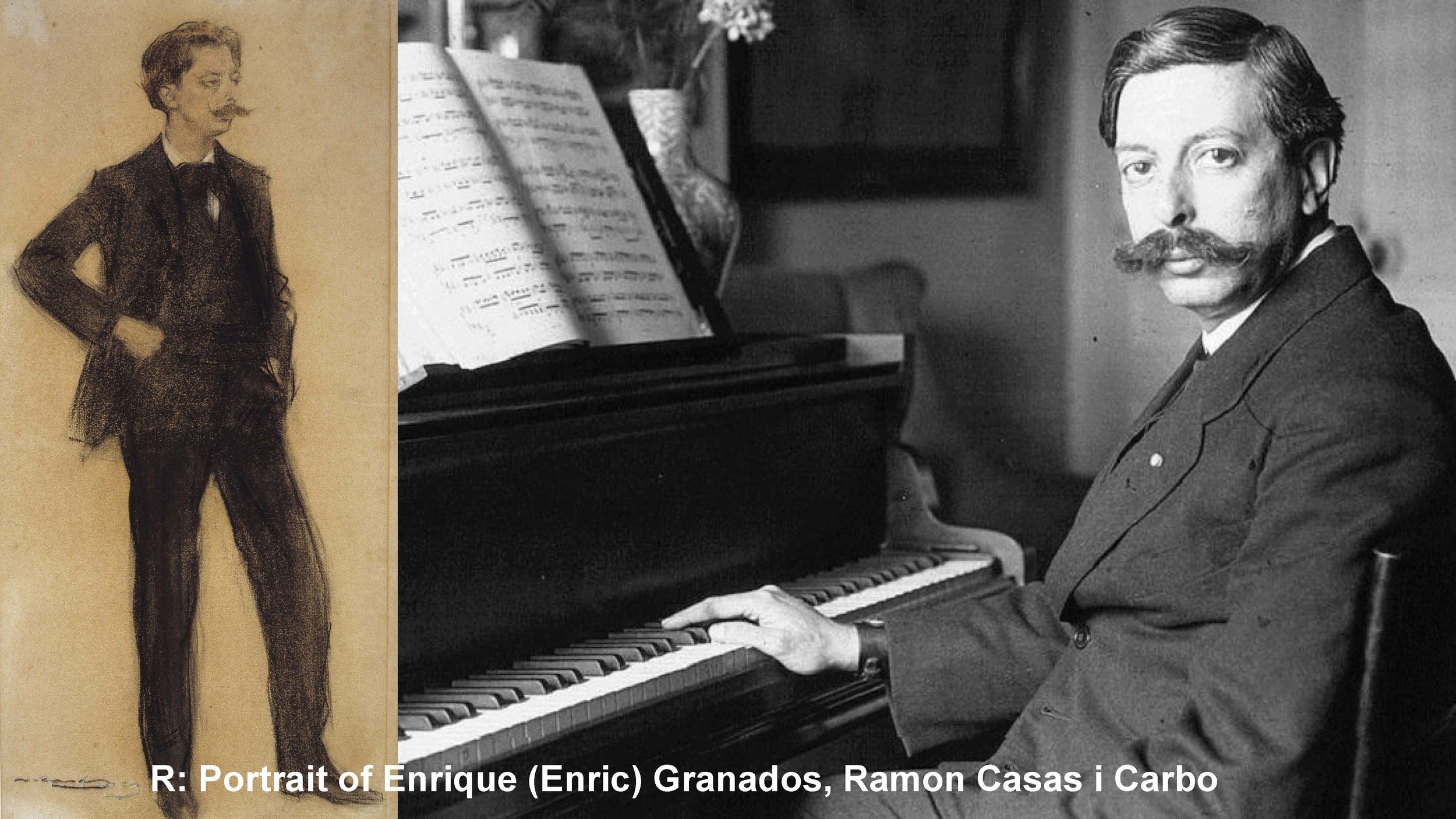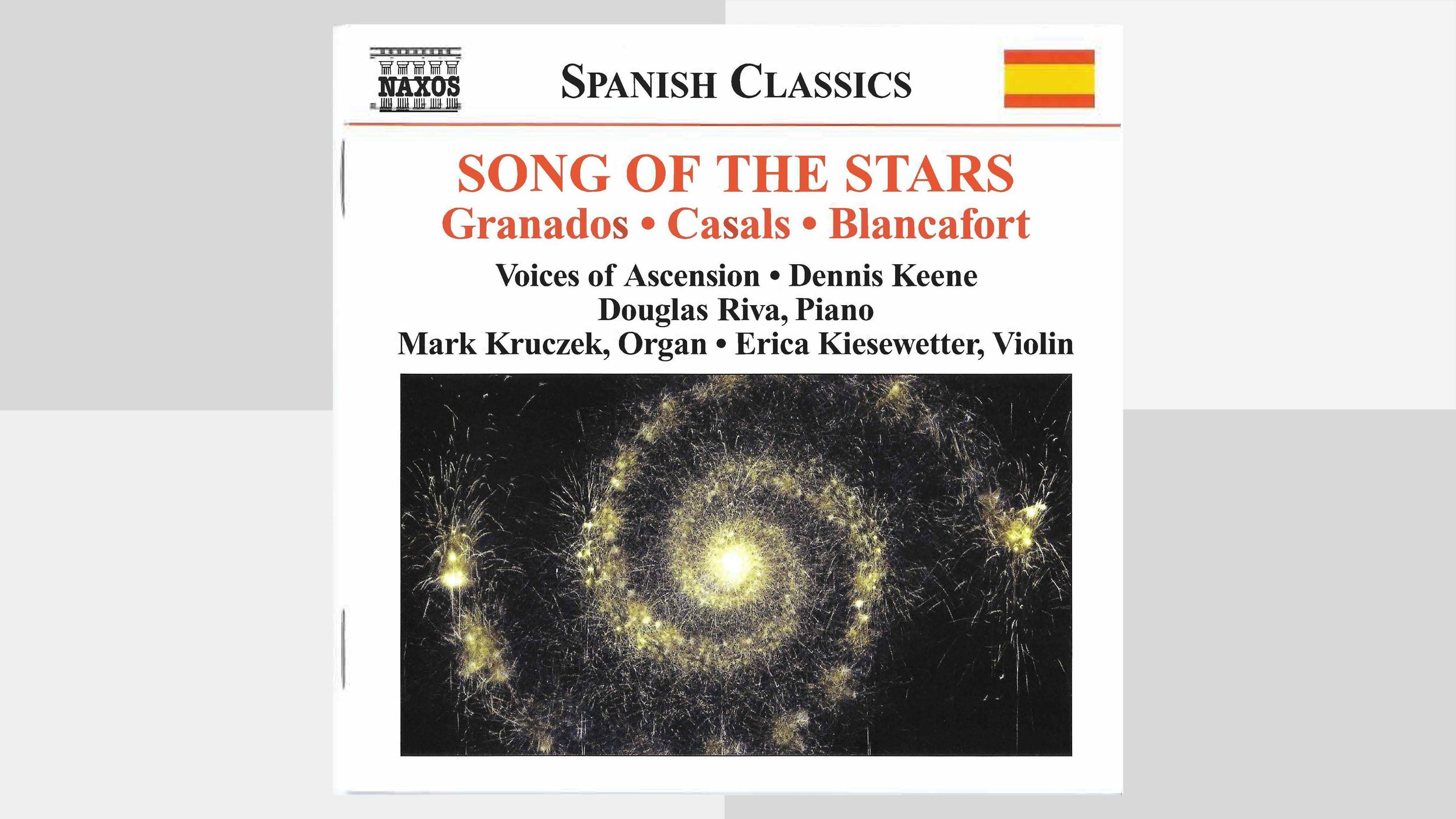Notes on the Program
Voices of Ascension celebrates the centenary of Enric Granados in collaboration with the CUNY Foundation for Iberian Music, The Hispanic Society, the Government of Catalonia, the Farragut Fund, the Sorel Organization, and the Consulate General of Spain in New York, with this performance for chorus, soprano, violin, piano, and organ.
Granados' long-lost choral fantasy for three choruses, piano, and organ, Song of the Stars, is the focal point of this concert, balanced by the piano version of de Falla’s El Amor Brujo – both epic tales of love and death, yearning and freedom.
The musical style of Granados is further revealed in a “Romanza” for violin and piano and “Escena religiosa” for violin, piano, and organ. His great opera Goyescas, premiered at the Metropolitan Opera in 1916, and the manuscript of which he gave to The Hispanic Society, is represented by a performance of the aria for soprano, ”La maja y el ruisenor,” coupled with the delightful “Gracia mia.”
Choral settings of sacred and folk texts as well as poetry of García Lorca by Casals, Morera, and Oltra represent the Catalan choral tradition, which is subtly nuanced and expresses vast emotional range.
VoA presented the North American premiere of Song of the Stars in 2007 and recorded a GRAMMY nominated CD for Naxos. Pianist Douglas Riva, whose efforts led to the recovery of the long-lost score, worked with VoA Artistic Director and Conductor Dennis Keene to research the musically and culturally significant body of Catalan choral music.
Event Soloists
Vanessa Vasquez
soprano
Francesca
dePasquale
violin
Vanessa Perez
piano
Douglas Riva
piano
Michele Scanlon
piano
Mark Kruczek
organ
Rosarium Beatae Virginis Mariae
Pablo Casals, 1876-1973
Pau (Pablo) Casals was born in El Vendrell (near Barcelona) in 1876 and died in San Juan, Puerto Rico in 1973. Casals was celebrated throughout the world as cellist, conductor and as a fighter for human rights. He was also a composer of a small body of very beautiful music.
These choral works were composed for the men and boy choir of the monastery in Montserrat, Spain. Each piece reveals his ability to express spiritual feelings in a simple, genuine and personal manner.
The Rosaries was intended to be sung in the services at Montserrat. The work is a series of very short movements, and is inspired by the tradition of congregational sections alternating with sections for chapel choir or soloists. Each movement has a different color and mood, some evoking Medieval or Renaissance styles.
Romanza, Escena religiosa
Enric Granados, 1867-1916
Granados’ Romanza for violin and piano is an overlooked gem of the repertoire. Dedicated to his friend Lázaro Clariana, Romanza is a work in the Romantic style, highly emotional and poetic.
Escena religiosa (Religious Scene) was dedicated “to the memory of beloved Doña Cecilia”, wife of Granados’ patron, Eduardo Conde. The work was probably composed for her funeral. Granados used a highly unusual instrumental combination in this composition, written for piano, organ and violin. The manuscript also called for a few notes to be played on the timpani, which have been transferred to the piano for tonight’s performance. The manuscript contains a text placed above the score. It is not clear if Granados’ intention was for the text to be read prior to the performance or if it was intended to reveal the inspiration of the composer:
Angel: Come, my soul, God calls you to reward your martyrdom.
Soul: I will live with God and pray for my family.
“I was delighted when Doug approached us for this project because it is a rare opportunity to perform a lost masterpiece. Cant de les estrelles IS a masterpiece, one of Granados’s finest compositions.”
Ave Maria, El Rossinyol (The Nightingale)
Enric Morera, 1865-1942
Enric Morera was born and died in Barcelona. He composed several operas and various instrumental works, but is best known today for his choral arrangements of Catalan folk songs, of which El Rossinyol may well be the most famous of all.
In Ave Maria, he set the simple treble solo against a luminous background of women’s voices. After a brief emotional outpouring, the calm melody returns in the men’s voices.
El Amor Brujo Suite for Piano
Manuel de Falla, 1876-1946
El Amor Brujo (Love, the Magician) is a ballet composed in 1914-1915 by Manuel de Falla to a libretto by Gregorio Martínez Sierra. The ballet was later revised, and arranged for orchestra and as a piano suite.
The work is distinctively Andalusian in character with music of remarkable beauty and originality. The plot is disarmingly simple – a gypsy is possessed by the ghost of her faithless former lover until her new suitor enlists a beautiful friend to entice the ghost away. Finally the two lovers, at last freed from the stifling burdens of their past, emerge from a night of sorcery to face the wondrous splendor of a new dawn. While the piano suite has no explicit narrative, its movements hearken to the ballet and orchestral versions.
A “Pantomime” conjures a meltingly lovely reverie in 7/8 meter. The “Song of the Will o’ the Wisp” evokes elusive desire. The piquant “Dance of Terror” is relentless in its intensity. “The Magic Circle” summons timeless wonderment. In “Minuit” the clock strikes 12, leading to the final “Ritual Fire Dance”.
Slides from our 2/2/2017 Event at CUNY Elebash Recital Hall
Recordare,Virgo Mater,
Casals
Casals’ exceptionally beautiful melody is given to all the women of the chorus - all sopranos and altos in unison - while the men provide the harmonic accompaniment. The work is brief, direct and deeply felt.
Nigra Sum
Composed for the boys at Montserrat (without men’s voices), this is one of Casals’ most popular compositions. The floating treble vocal lines and touching melodies perfectly depict the tender, familiar biblical text.
Eco, Preludio
Manuel Oltra, 1922-2015
Manuel Oltra was one of Catalonia’s most distinguished composers and teachers. His Eco and Preludio come from a set of Three Songs of Love on texts by Garcia Lorca. Composed in 1965 and 1964, they display a brilliant ability to compose for the choral instrument, and they each create the wonderfully vivid atmospheres of the unique Lorca poems.
La maja y el ruiseñor from Goyescas, Gracia mia
Granados
In spite of a fear of travel by sea, Granados agreed to come to New York for the premiere of his opera Goyescas. On January 28, 1916, Goyescas was premiered at the Metropolitan Opera to positive reviews by the American audience and critics. Granados’ opera, based on early paintings by Francisco Goya, was the first to be performed in Spanish and featured the talents of Giovanni Martinelli and Giuseppe De Luca. Though it was well-received, the work was never performed again at The Met.
While in New York for the premiere, Granados received an honorary membership in the Hispanic Society of America and was presented by founder and president, Archer Huntington, with the Silver Medal of Arts and Letters. Granados in turn inscribed a musical phrase on one of the columns in the central hall of the Society´s building and he also gave the Hispanic Society the original manuscript of the vocal score of Goyescas which has been shared with Voices of Ascension for this performance.
Originally appearing as the fourth piece of Granados’ piano suite Goyescas, the aria “La Maja y el Ruisenor” is based on a folk song which Granados heard a young woman sing in the countryside surrounding Valencia. He transforms the melody through a series of variations culminating in a cadenza imitating the song of the Nightingale.
“Gracia Mia”, from Canciones amatorias, is an exuberant love song. In contrast to the sorrow of Rosario and her nightingale, this is a reminder that love can be a joyous and extravagant.
Explore the Goyescas Manuscript, gift of Granados to the Hispanic Society in 1916
Courtesy of the Hispanic Museum and Library
Notes on Cant de les estrelles by Douglas Riva
On the night of March 11, 1911 one of the most significant concerts in the history of Spanish music took place at Barcelona´s Palau de la Música Catalana. The program was devoted entirely to the music of Granados, all performed by the composer himself. That night, only four months shy of his 44th birthday, Granados was aware that he was presenting himself to the world as a mature composer and pianist. The program included the World Premieres of his piano suite Goyescas and of Azulejos [Mosaic Tiles], a work by Albéniz which Granados completed after Albéniz’s death at the request of his widow. Other works performed included Granados’ Valses poéticos and Allegro de concierto.
“Comparable to a piano concerto with chorus and organ rather than an orchestra, Granados wrote Cant de les estrelles as a vehicle for himself ”
Critics were unanimous in their praise. However, one work in particular was singled out: Cant de les estrelles [Song of the Stars], which was performed with the chorus Orfeó Català. Scored for piano solo, organ and choruses, it was the only ensemble work on the program. Granados had conceived Cant de les estrelles specifically for performance by the Orfeó Català in the Palau de la Música Catalana. The chorus was divided into three groups, two on the on the stage and the third, a women´s chorus, placed above the auditorium near the cupola, which provided a poly-choral antiphonal effect.
Cant de les estrelles is a masterpiece, one of Granados’ finest compositions. It was composed in the Romantic-modernista style, with post-Wagnerian harmonies and no traces of Spanish nationalism. Comparable to a piano concerto with chorus and organ rather than an orchestra, Granados wrote Cant de les estrelles as a vehicle for himself although he dedicated it to the pianist Mieczyslaw Horszowski (1892-1993). The work opens with an extended piano solo of considerable virtuosity, followed by a duet for organ and piano and only then does the chorus enter.
Cant de les estrelles is a highly unusual work but it is not unique in the genre. Other works have also been composed for piano, organ and chorus, such as Ave María by Rossini and Dextera Domini by César Franck. However, the scope and inspiration of Cant de les estrelles places it at the forefront of Granados’ works.
Cant de les estrelles is subtitled “Poem for piano, organ and voices inspired by a poem by Heine”, referring to the German poet Heinrich Heine. According to Heine expert Peter A. Shea, the non-attributed Catalan text set by Granados is not a translation of any specific poem by Heine nor is it a free translation. Rather, Mr. Shea believes that the text is a kind of response to one or more Heine poems which deal with love and the stars, but in this case written from the point of view of the stars themselves. He suggests that a possible source of Granados’ inspiration could be Heine’s Lyric Intermezzo, No. 8. Granados did not read or speak German and thus must have read Heine’s poetry in translation or with the assistance of a German-speaking colleague such as the Catalan poet and dramatist Apel.les Mestres, who had translated the Lyric Intermezzos into Catalan in 1895.
Theoretically at least, Apel.les Mestres would seem the most likely author of the text. However, Granados always attributed to their authors the texts he used in his compositions, and certainly would have done so in the case of a poet of the stature of Apel.les Mestres. In addition, the text does not resonate with the style of other works by Apel.les Mestres. Walter A. Clark, author of Enrique Granados: Poet of the Piano (Oxford University Press, 2006) observed that “the preoccupation with death expressed in the final strophe is eerily portentous of the fate soon to visit the other possible author of these lines: Granados himself.”
In spite of its success Granados did not publish the score of Cant de les estrelles. Unfortunately neither he nor any other pianist had occasion to perform it again. Following Granados’ death the various manuscripts of Cant de les estrelles remained in the family archive until 1938 when his son Víctor, with or without the knowledge of other family members, brought the manuscripts of that piece as well as those of orchestral works Romeo y Julieta and Torrijos along with that of the opera María del Carmen to New York. Once in New York Víctor signed a contract with Nathanial Shilkret for their publication. Shilkret was a well-known as a conductor, composer and recording producer. He immediately realized the importance of the Granados manuscripts.
“In 1964 the Shilkret archive suffered a fire and all the manuscripts were feared lost. Through the years the Granados family, with the assistance of José Iturbi and Alicia de Larrocha, made numerous attempts to recover the manuscripts without result.”
However, Víctor was not the sole heir to his father’s music and consequently was not authorized to enter into any contractual agreements without the consent of other members of the Granados family. Communication between New York and Barcelona was difficult at best due to World War II and the matter could not be resolved, in spite of repeated attempts on the part of Mr. Shilkret and others.
From this point the story becomes increasingly complicated. Those interested might want to consult Walter A. Clark’s Lost and Found: Granados’ Cant de les estrelles for Piano, Organ and Chorus orMargaret M Barela’s “Out of Obscurity, Into the Light” in the January, 2007 issue of International Piano. For a historical fiction novel based on the life of Granados see The Fallen Nightingale by John W. Milton, Swan Books, 2005.
The various Granados manuscripts remained in the Shilkret archive for decades. In 1964 the Shilkret archive suffered a fire and all the manuscripts were feared lost. Through the years the Granados family, with the assistance of José Iturbi and Alicia de Larrocha, made numerous attempts to recover the manuscripts without result. In 1982 Granados’ daughter, Natalia and her husband Dr. Antoni Carreras i Verdaguer appointed Douglas Riva as the family representative in this matter. Years of contacts between the parties failed to yield any result. However, the story has a happy ending thanks to the efforts of Shilkret’s grandson Niel Shell. In 2004 an agreement was reached and the manuscripts were finally brought to light. Although the manuscripts of Cant de les estrelles had suffered water damage and mold as a result of the fire, fortunately, they were restored by Susan B. Martin. Editorial Boileau, Barcelona, published a critical edition of the score prepared by Douglas Riva. The second performance ever of the work took place in New York in March, 2007 with Voices of Ascension directed by Dennis Keene and Douglas Riva, piano. The concert was recorded for a Naxos CD which was nominated for a Grammy award. Ninety-six years after its first and only performance Granados’ glorious music finally reached the public. Subsequent performances have been given in many cities, London, Barcelona, Sydney, Madrid, Toronto, Washington, D. C., Padova (Italy), Minneapolis and El Paso, Texas among them.
Concert Sponsorship
Wine was provided by Vivanco Bodega Fundacion Experiencias compartiendo cultura de vino















































